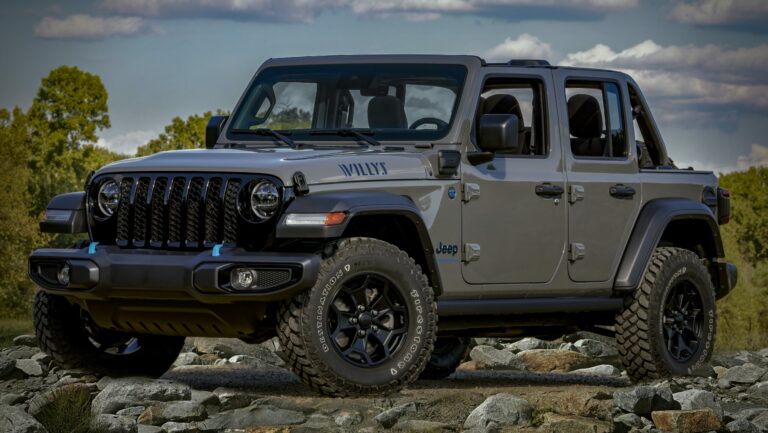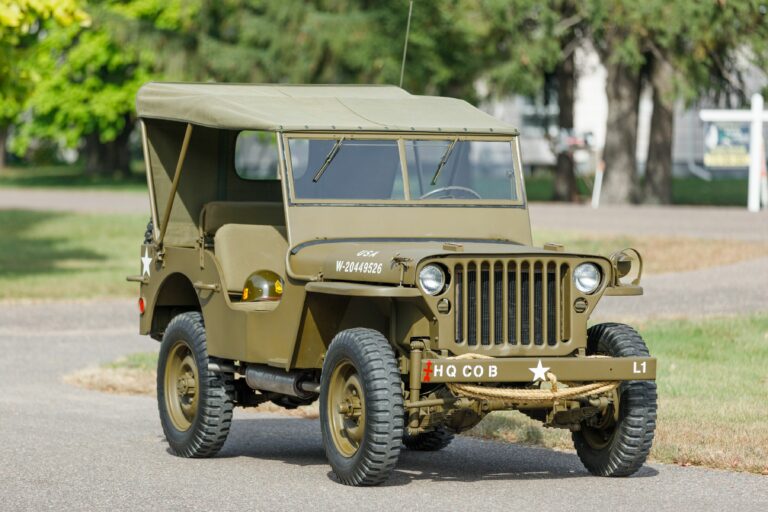1973 Jeep Truck For Sale: A Comprehensive Guide to Acquiring an American Icon
1973 Jeep Truck For Sale: A Comprehensive Guide to Acquiring an American Icon jeeps.truckstrend.com
Introduction: The Enduring Appeal of the 1973 Jeep Truck
In the annals of automotive history, few vehicles command the rugged respect and enduring admiration quite like the Jeep truck. Among its storied lineage, the 1973 Jeep Truck, part of the beloved J-series, stands out as a true American icon. More than just a utility vehicle, these trucks embody an era of robust simplicity, go-anywhere capability, and distinctive styling that continues to captivate enthusiasts and collectors today. Whether you envision it as a workhorse for your ranch, a trusty companion for off-road adventures, or a meticulously restored showpiece, finding a 1973 Jeep Truck for sale represents an opportunity to own a tangible piece of automotive heritage. This comprehensive guide will navigate you through everything you need to know about acquiring, evaluating, and appreciating these classic machines.
1973 Jeep Truck For Sale: A Comprehensive Guide to Acquiring an American Icon
The Enduring Legacy of the 1973 Jeep Truck
The 1973 Jeep Truck falls within the second generation of the J-series (originally known as the Gladiator), which began production in 1962. By 1973, these full-size pickups had evolved, offering a blend of utilitarian functionality and surprisingly comfortable driving dynamics for their time. The model year 1973 is particularly noteworthy as it occurred during the period when AMC (American Motors Corporation) owned Jeep, influencing powertrain options and design.
These trucks were available in various configurations, including the J-2000 (shorter wheelbase, lighter duty) and J-4000 (longer wheelbase, heavier duty), often equipped with either a straight-six or a V8 engine. Common engine choices for 1973 included the robust AMC 258 cubic inch (4.2L) inline-six and the potent AMC 360 cubic inch (5.9L) V8, paired with manual or automatic transmissions and Jeep’s legendary four-wheel-drive systems, including the innovative Quadra-Trac full-time 4WD.
What makes the 1973 model still highly sought after? Its timeless, no-nonsense design, characterized by the iconic seven-slot grille, sturdy body lines, and practical interior, appeals to purists. Beyond aesthetics, their mechanical simplicity makes them relatively easy to work on, and their legendary durability means many have survived decades of hard use. For many, owning a 1973 Jeep Truck is not just about transportation; it’s about connecting with a bygone era of American ingenuity and uncompromised capability.
What to Look For When Buying a 1973 Jeep Truck: Key Considerations
Acquiring a vintage vehicle like a 1973 Jeep Truck requires a discerning eye and a thorough understanding of potential pitfalls. The condition of these trucks can vary dramatically, from rusted-out farm relics to concourse-quality restorations. Here’s what to prioritize during your search:
1. Condition Categories: Setting Expectations
- Project/Parts Truck: Non-running, significant rust, incomplete. Ideal for experienced restorers or those needing parts. Expect extensive work and costs.
- Driver Quality: Runs and drives, roadworthy, but needs cosmetic work (paint, interior) and minor mechanical refreshing. A good starting point for a rolling restoration.
- Good Original: Well-preserved, mostly original, minimal rust, solid mechanically, and presentable. May need routine maintenance but largely retains its factory integrity.
- Restored/Show Quality: Professionally restored to original or custom specifications, excellent condition throughout. Commands the highest prices.

2. Mechanical Aspects: The Heart of the Beast
- Engine: Check for leaks (oil, coolant), smoke from the exhaust (blue for oil, white for coolant, black for rich fuel mixture), and unusual noises (knocks, rattles). The AMC 360 V8 is generally robust, but listen for signs of neglect.
- Transmission & Transfer Case: Test all gears, both forward and reverse. For manuals, check clutch engagement and slippage. For automatics, ensure smooth shifts. Engage 4WD (high and low range) and listen for grinding or clunking from the transfer case (e.g., Dana 20, Quadra-Trac).
- Axles, Suspension, Brakes: Look for leaks around differentials. Check leaf springs for sagging or cracks. Inspect brake lines, master cylinder, and calipers/wheel cylinders for leaks. Test brake effectiveness and pedal feel.
- Steering: Excessive play in the steering wheel indicates worn steering components (tie rods, steering box, ball joints).
3. Body and Frame: The Rust Monster
Rust is the primary enemy of vintage vehicles. Common rust spots on 1973 Jeep Trucks include:
- Cab Corners and Rocker Panels: These areas often collect moisture.
- Floor Pans: Especially under the driver and passenger feet.
- Bed Floor and Wheel Wells: Due to exposure to elements and cargo.
- Frame Rails: Critically important for structural integrity. Check thoroughly for perforations, significant surface rust, or past repairs.
- Fender Wells and Inner Fenders: Can hide rust that spreads to the body.
4. Interior: Comfort and Functionality
Assess the condition of seats (tears, foam integrity), dashboard (cracks, fading), door panels, and headliner. Ensure all gauges, lights, wipers, and the heater/blower motor are functional. Originality here can add value, but tasteful upgrades are also common.
5. Electrical System: A Common Vintage Vehicle Headache
Older wiring can become brittle or corroded. Check all lights (headlights, taillights, turn signals, brake lights), horn, and accessories. Unexplained electrical gremlins can be time-consuming to diagnose.
6. Documentation: The Paper Trail
Always verify the vehicle’s title. Ensure the VIN on the title matches the vehicle. Any service records, past registration documents, or historical information can add significant value and peace of mind.
Navigating the Market: Where to Find a 1973 Jeep Truck For Sale
The search for a vintage Jeep truck can be an adventure in itself. Here are the most effective avenues for finding a 1973 model:
- Online Marketplaces:
- eBay Motors: Often has a wide selection, from projects to restored examples. Pay close attention to seller ratings and detailed descriptions.
- Facebook Marketplace/Groups: Many classic truck and Jeep enthusiast groups exist, where members often buy, sell, and trade. Great for local finds.
- Craigslist: Excellent for local, often lower-priced, private party sales. Be wary of scams and always inspect in person.
- Specialized Classic Car/Truck Websites:
- Hemmings.com: A premier marketplace for classic and collector vehicles, often featuring higher-quality or professionally restored trucks.
- ClassicCars.com: Another reputable site with a good inventory of vintage vehicles.
- Bring a Trailer (BaT): An auction site known for curated, well-documented collector vehicles. While not daily fare, a well-preserved Jeep truck might appear.
- Forums and Enthusiast Communities: Dedicated Jeep J-series forums or classic truck forums often have "for sale" sections where passionate owners list their vehicles. This can be a great way to find well-maintained trucks from fellow enthusiasts.
- Auctions: While major auctions (like Mecum or Barrett-Jackson) might feature high-end restorations, local classic car auctions can sometimes yield interesting finds.
- Word-of-Mouth/Local Finds: Don’t underestimate the power of networking. Let friends, local mechanics, and auto parts store owners know you’re looking. Sometimes the best deals are found in someone’s backyard.
When searching online, use specific keywords like "1973 Jeep J-series," "1973 Jeep Gladiator," "1973 Jeep pickup," or "AMC Jeep truck." Filter by price, location, and condition to narrow your results.
The Buying Process: Tips for a Successful Purchase
Once you’ve found a potential candidate, the real work begins.
- Set a Realistic Budget: Beyond the purchase price, factor in costs for transport, immediate maintenance, potential restoration work, insurance, and registration. Vintage vehicles always cost more than anticipated.
- Pre-Purchase Inspection (PPI): This is non-negotiable. If possible, hire a qualified mechanic specializing in vintage vehicles or Jeeps to perform a thorough inspection. This can uncover hidden issues and save you thousands in future repairs. If buying remotely, consider a third-party inspection service.
- Test Drive: If the vehicle is running, take it for a comprehensive test drive. Pay attention to how it starts, idles, accelerates, shifts, brakes, and handles. Listen for unusual noises, feel for vibrations, and note any pulling or wandering.
- Negotiation: Do your research on current market values based on condition. Be prepared to negotiate, but also be prepared to walk away if the price isn’t right or if significant issues are uncovered.
- Logistics: If purchasing from out of state, arrange for secure transport. Ensure the seller has a clear title in hand.
Owning a 1973 Jeep Truck: Challenges and Rewards
Owning a vintage vehicle is a lifestyle choice that comes with its own set of challenges and immense rewards.
Challenges:
- Parts Availability: While many mechanical components are shared with other AMC/Jeep vehicles of the era, some body panels or specific trim pieces can be difficult to find. Online forums and specialized vendors are your best friends.
- Fuel Economy: These trucks were not designed for efficiency. Expect single-digit to low-teen miles per gallon, especially with the V8.
- Modern Safety Features: ABS, airbags, and crumple zones are non-existent. Drive defensively and be aware of your vehicle’s limitations.
- Maintenance Frequency: Older vehicles often require more frequent and specialized maintenance than modern cars. A good understanding of basic mechanics or a reliable vintage mechanic is essential.
Rewards:
- Unique Style and Character: A 1973 Jeep Truck turns heads wherever it goes. It’s a conversation starter and a testament to classic design.
- Off-Road Capability: True to Jeep’s heritage, these trucks are incredibly capable off-road, ready for adventures on trails or in the backcountry.
- Connection to History: You’re not just driving a vehicle; you’re preserving a piece of American automotive history.
- Potential for Appreciation: Well-maintained or expertly restored examples of these trucks have shown a steady increase in value, making them a potential investment.
- DIY Friendly: Their simpler mechanical design makes many repairs and upgrades accessible to the home mechanic, fostering a deeper connection with your vehicle.
1973 Jeep Truck For Sale: Estimated Price Guide
Please note that prices for vintage vehicles fluctuate based on market demand, regional differences, specific options, and, most critically, the vehicle’s condition. The following table provides a general guide.
| Condition Category | Description | Estimated Price Range (USD) | Key Factors Influencing Price |
|---|---|---|---|
| Project/Parts | Non-running, significant rust, major mechanical issues, incomplete. Requires extensive work. | $1,500 – $5,000 | Extent of rust, completeness, title status, engine presence. |
| Driver Quality | Runs and drives, roadworthy, but needs cosmetic work, minor mechanical fixes, or general refreshing. | $5,000 – $15,000 | Engine/transmission health, minimal rust, interior condition, functionality of all systems. |
| Good Original | Well-preserved, mostly original, minimal rust, solid mechanically, presentable but not show-quality. | $15,000 – $25,000 | Originality of paint/interior, low mileage, excellent mechanicals, minimal modifications. |
| Restored/Show | Professionally restored to original or custom specifications, excellent condition throughout, show-ready. | $25,000 – $60,000+ | Quality of restoration, originality (concours vs. restomod), rare options, provenance. |
Disclaimer: These are approximate ranges as of late 2023/early 2024. Actual prices may vary significantly.
Frequently Asked Questions (FAQ) about the 1973 Jeep Truck
Q1: What engine options were typically available in a 1973 Jeep Truck?
A1: The most common engine options for the 1973 Jeep Truck (J-series) were the AMC 258 cubic inch (4.2L) inline-six and the more powerful AMC 360 cubic inch (5.9L) V8.
Q2: Are parts hard to find for a 1973 Jeep Truck?
A2: Many mechanical parts are relatively accessible due to commonality with other AMC/Jeep models of the era. However, specific body panels, unique trim pieces, or certain interior components can be challenging to locate and may require searching specialized vintage parts suppliers or online forums.
Q3: What’s the typical fuel economy for a 1973 Jeep Truck?
A3: Fuel economy is not a strong suit. Expect anywhere from 8-15 miles per gallon, depending on the engine, transmission, gearing, and driving conditions. The V8 will typically be on the lower end of that range.
Q4: Can a 1973 Jeep Truck be a reliable daily driver?
A4: With proper maintenance, a 1973 Jeep Truck can be a reliable daily driver. However, it requires a commitment to regular upkeep and an understanding that it lacks modern safety features and conveniences. It’s more suited for someone who appreciates vintage vehicles and is prepared for hands-on ownership.
Q5: What are the most common rust spots to check on these trucks?
A5: Key areas prone to rust include the cab corners, rocker panels, floor pans (especially under the pedals), the bed floor, inner and outer fender wells, and crucially, the frame rails. Thorough inspection of these areas is paramount.
Q6: What’s the difference between a "J-series" and a "Gladiator" when referring to these trucks?
A6: The Jeep truck line was initially launched in 1962 as the "Gladiator." Over time, it evolved into the "J-series" (e.g., J2000, J4000) designation. By 1973, they were officially known as J-series trucks, but many enthusiasts still affectionately refer to them as Gladiators, honoring their original lineage.
Q7: Is a 1973 Jeep Truck a good investment?
A7: While enjoyment should be the primary motivation, well-preserved or professionally restored 1973 Jeep Trucks have shown appreciation in value over time, especially as interest in classic pickups grows. A truck in "driver" or "good original" condition can also be a solid investment if maintained and eventually restored.
Conclusion: Your Adventure Awaits
The 1973 Jeep Truck is more than just a vintage vehicle; it’s a statement, a piece of living history, and a gateway to countless adventures. Acquiring one requires patience, diligent research, and a willingness to embrace the quirks and charms of classic ownership. By understanding what to look for, where to search, and what to expect during the buying process, you can confidently navigate the market for a 1973 Jeep Truck for sale. Whether you plan to restore it to its former glory, outfit it for off-road expeditions, or simply enjoy its rugged authenticity, owning this iconic truck promises a rewarding and unique experience. Your journey into the world of classic Jeep ownership is an investment not just in a vehicle, but in a lifestyle.





